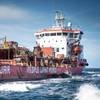A "red tide" outbreak is widening in southern Chile's fishing-rich waters, the government said on Wednesday, deepening what is already believed to be one of the country's worst environmental crises in recent years.
The red tide - an algal bloom that turns the sea water red and makes seafood toxic - is a common, naturally recurring phenomenon in southern Chile, but the extent of the current outbreak is unprecedented.
The southern region of Los Lagos has been affected in recent weeks by the largest red tide in its history, prompting fishermen deprived of their livelihoods to angrily demand more support from the government.
Now there are signs that Los Rios, the neighboring region to the north, has also been affected, local officials warn.
"The red tide zone is going to grow, it is a changing phenomenon," Raul Sunico, the deputy minister for fishing and aquaculture, told local radio station Cooperativa.
"Highly toxic samples have been taken in the region of Los Rios, which obliges us ... to close areas of the region to resource extraction."
The red tide has caused tonnes of dead shellfish to wash up on southern beaches and paralyzed the fishing industry, which is the mainstay of many coastal settlements. Fishing accounts for about 0.5 percent of the country's gross domestic product.
Fishermen have blocked access to the island of Chiloe in protest over what they consider to be inadequate government compensation for their losses, leaving locals and tourists alike stranded.
The government initially offered 100,000 Chilean pesos ($147) to each family affected crisis, but increased it to 300,000 pesos after complaints.
Scientists say this year's El Niño weather pattern is likely a key factor in the red tide, as it warms the ocean and creates bloom-friendly conditions.
Some fishermen are blaming the local salmon industry, the world's second largest, for exacerbating the problem, citing the dumping of dead fish in March by salmon farmers after a bloom killed off much of their stock.
The government estimates some 100,000 tonnes of salmon were lost, leading to a jump in global prices for the fish.
The disruption of sealife along Chile's coast, in turn, has caused birds such as albatrosses and petrels to leave for other areas with better food sources. The bloom also was a factor in the mass beaching of whales and sea-lions, authorities say.
Sardine fisherman in the Bio-Bio region have reported an abundance of octopuses but scarce numbers of sardines. Elsewhere, enormous jack mackerel have been seen while the usual hake have almost disappeared.
($1 = 680.7000 Chilean pesos)
(Reporting by Fabian Cambero and Rosalba O'Brien; Editing by Paul Simao)
















